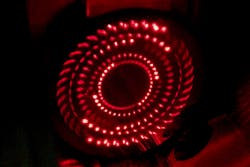Absorption spectroscopy measurement sensitivity improves as the path length of a gas absorption cell increases. Conventional White and Herriott gas cells with absorption path lengths on the order of 10 m have typical lengths of ~30 cm and volumes of ~250 mL for a Herriott cell and 2 L for a White cell.
With an aim to create gas cells that deliver long absorption path lengths in a smaller package, president and cofounder of Sentinel Photonics (Monmouth Junction, NJ) Stephen So spent several months writing a ray-tracing program from scratch to model multipass cell optical patterns, recognizing that existing modeling software was inadequate. So—inspired by artificial intelligence (AI) optimization used by players of the video game StarCraft—he implemented similar AI optimization routines in his code to find the most effective beam patterns, built his own quasi-supercomputer using video-game graphics cards linked in parallel, and was able to find long-path-length solutions in eye-catching dense spot patterns (such as spiral and fish shapes) while only using two simple spherical mirrors.1
Sentinel cofounder David Thomazy took the designs generated by the computer program and built the first prototype cells in his garage. The now patented ultracompact multipass cell designs are offered in cells with an up to 57.6 m path length in a 17 × 6.6 cm package—more than 10X smaller than conventional designs with equivalent sensitivity. Sentinel’s design technique can create compact multipass cells with varying optical path length, such as a 3.7 m path cell in a 7.6 × 4.8 cm package.
Optimized beam patterns
The current gas-cell design consists of a two-mirror configuration of metal or dielectric coated spherical mirrors. In the 57.6 m path-length cell, more than 450 beam passes are made across the pair of 40-mm-diameter mirrors with optimized parameters that minimize spot overlap, hence minimizing etalon fringe effects—typically the barrier to better sensitivities in laser absorption spectrometers. The cell also features a small sampling volume of only 225 mL for reduced gas-exchange times compared to traditional gas cells.
In the first published study using the new 57.6 m cell design, the spherical mirrors were coated to > 99.8% reflectivity in a selected 3.36 μm region to measure ethane (C2H6) to part-per-billion sensitivity levels in 1 s.2 Although the ultracompact multipass cell is similar to a Herriott cell with two coaxial spherical mirrors, the unique ray-tracing solution creates spot patterns that cover more of the mirror surface and follow a more complicated pattern than simple circles or ellipses used in standard spherical Herriott cells (see figure). The AI modeling routine varies the input beam direction, the entrance location, and the physical distance between the mirrors to optimize the overall path length, inter-spot distance, and exit-hole distance relative to other spots.
By using standard concave spherical mirrors, manufacturing and alignment tolerances are easier to achieve—and cost less—than alternative mirror cells that use astigmatic mirrors. The key to the technology is that it embraces rather than avoids optical aberrations. Although these aberrative effects cause the spot to become more ellipsoid in shape with each transit, collecting practically all of the light is still possible because the cell design allows the beam to emerge cleanly without hitting the edges of the entrance and exit hole.
“Sentinel’s multipass cell is a powerful new tool for laser-based sensing applications, particularly when small sensor footprint, long optical path length, and simple construction are high priorities,” says So.
REFERENCES
1. See http://www.google.com/patents/US20120242989.
2. K. Krzempek et al., Appl. Phys. B, doi:10.1007/s00340-013-5544-9 (2013).

